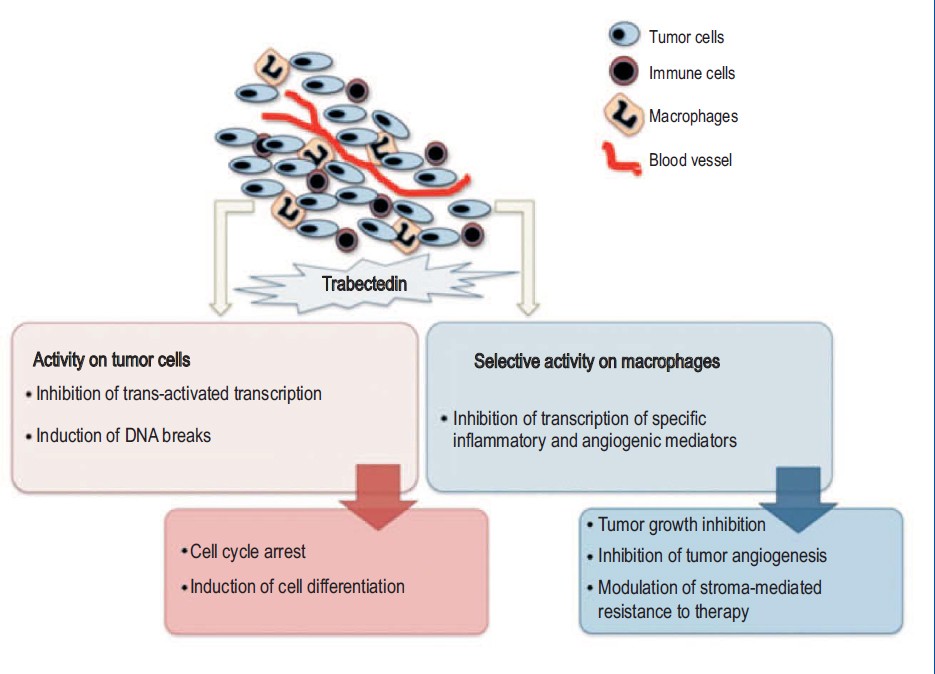LURBINECTEDIN EEUU : LAS VENTAS EN EL 1er SEMESTRE 25 HAN SIDO DE 137,5 MILL$ // SE HAN REDUCIDO UN 12% QUE SON 18,6 MILL$ MENOS Vs A LAS ALCANZADAS EN EL MISMO PERIODO DE 2024 QUE FUERON DE 156,1 MILL$ // VENTAS DE TARLATAMAB EN.EL 2o TRIM 25 HAN ALCANZADO LOS 134 MILL$ ... UN 65% MÁS ... VERSUS LOS 61 MILL$ QUE ALCANZÓ EN EL 1er TRIM25 // TARLA 1er SEMESTRE 25 = VENTAS DE 215 MILL$ ... QUE SON 77,8 MILL$ MÁS QUE LOS ALCANZADOS POR LURBI (137,5 MILL$) EN EL MISMO PERIODO
19 diciembre 2018
Lynparza® de AstraZeneca ( conocido como inhibidor de PARP Olaparib ) Combinado con Yondelis . TOP-ART-Studie: Den Krebszellen gezielt das Reparaturwerkzeug wegnehmen.


Die Phase 2-Studie prüft bei Patienten mit molekulargenetisch nachgewiesenen Störungen in der DNA-Reparatur die Therapie mit dem PARP-Inhibitor Olaparib in Kombination mit dem Medikament Trabectedin.
Jeder Krebs geht auf Erbgutveränderungen zurück. Meist sind sie im Laufe des Lebens in einzelnen Körperzellen entstanden, seltener von den Eltern vererbt. Zu den Erbgutveränderungen kommt es durch verschiedene Mechanismen, etwa durch Kopierfehler bei der DNA-Verdoppelung oder durch defekte DNA-Reparaturenzyme. Metastasierte solide Tumoren weisen häufig Veränderungen in Genen auf, die für die Reparatur von genetischen Schäden wie zum Beispiel DNA-Doppelstrangbrüchen entscheidend sind. Solche für die Zelle essentielle Gene sind unter anderem BRCA1/2, CHEK2 und PALB2. Ihre eigentliche Aufgabe ist es, durch die sogenannte „homologe Rekombination (HR)“ Fehler im Erbgut der Zelle zu beheben. Dabei tauschen sie genetisches Material zwischen den sich entsprechenden, also homologen Chromosomen des doppelten Chromosomensatzes oder zwischen verdoppelten Schwester-Chromatiden in der Phase der Zellteilung aus. ...
Melanoma / Yondelis . Antimetastatic and Antiangiogenic Activity of Trabectedin in Cutaneous Melanoma .
*.- Tumor Angiogenesis Unit, Department of Oncology, IRCCS-Istituto di Ricerche Farmacologiche Mario Negri, Bergamo, Italy.
*.- Mouse and Animal Pathology Lab, Fondazione Filarete, Italy and Department of Veterinary Pathology, University of Milan, Milan, Italy.
*.- Laboratory of Cancer Pharmacology, Department of Oncology, IRCCS-Istituto di Ricerche Farmacologiche Mario Negri, Milan, Italy.
 Published : 13 December 2018.
Published : 13 December 2018.Abstract :
Trabectedin is a marine-derived anti-neoplastic drug. Besides targeting the cancer cells, trabectedin has a peculiar activity on the tumor microenvironment with marked effects on the vasculature and the immune response. Since a favorable microenvironment is a key factor in the progression of cutaneous melanoma, we hypothesized that trabectedin might affect the growth and metastasis of this highly aggressive cancer.
This study shows that trabectedin inhibited the subcutaneous growth of the murine melanoma B16-BL6 and K1735-M2. In line with its known activities on the environment of other tumor types, it caused a significant reduction of tumor blood vessel density and tumor-associated macrophages. Trabectedin had a significant antimetastatic activity, inhibiting the formation of lung colonies following i.v. injection of B16-BL6 or K1735-M2 cells.
 The drug was also active in a clinical-relevant spontaneous metastasis assay, where it inhibited lung metastasis when administered before (neo-adjuvant) or after (adjuvant) surgical removal of the primary tumor.
The drug was also active in a clinical-relevant spontaneous metastasis assay, where it inhibited lung metastasis when administered before (neo-adjuvant) or after (adjuvant) surgical removal of the primary tumor.
Relevant to its antimetastatic activity, trabectedin inhibited melanoma cell invasiveness in vitro, associated with increased TIMP-1 production and alteration in cell shape and cytoskeleton organization.
This study shows that trabectedin affects melanoma growth and metastasis, acting with tumor-dependent mechanisms on both the tumor cells and the vascular and the inflammatory tumor microenvironment.


